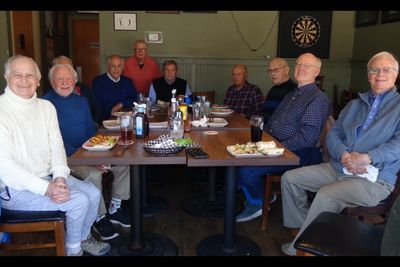Library interview with Peter Gill, Dave Hunter and Brian Harrison
The Men's Book Club, of which these three men are members, seems to be a rarity, and has some differences between women's book clubs, the author found.
Ilze Andzans, NOTL Public Library Board Member
Apr 25, 2024
The Niagara-on-the-Lake Public Library board and staff are interested in exploring the special place books, reading, storytelling and libraries hold in the hearts of our community members. The power of the written and spoken word, the enchantment of libraries and childhood memories of time spent with books, creates a profound tapestry of emotions and experiences. This questionnaire prompts introspection and reflection, offering a unique lens through which to examine the bond between readers and their connection to books, storytelling and libraries. Watch this space for interviews with an array of interesting community members.
This interview is a bit different from others in the series, as I interviewed three members of a Men’s Book Club and the story is not so much about their individual preferences and memories, as it is about the longevity of a unique book club, friendship, shared ideas, expanding horizons and the power of books to transport us into another world. Conducting the interview also broadened my own horizon with respect to a very specialized genre of literature — science fiction.
The Men’s Book Club started 21 years ago, when Peter Gill and John Watson listened to their wives talk about their book club and thought ‘what the heck, why not?’ The NOTL librarian of the day, Gerda Molson, was dubious about establishing a men's book club, but went along with it, suggesting the first eight or nine titles. Almost from the beginning, it was a mix of fiction and nonfiction and that trend continues to this day. For many years, the book club members would gather at one another’s houses, but three years ago they moved from evening meetings at private homes to a lively afternoon at the Sandtrap Pub and Grill.
The Men’s Book Club has about 14 members from a variety of backgrounds: lawyers, former winemakers, engineers, teachers, real estate agents, foreign service employees, a retired judge and a couple of fundraising experts. It has grown over time, expanding to include friends of friends. A variety of backgrounds ensures a broad range of topics of interest to the group.
Men’s book clubs are still a rarity. I expected a difference in reading choices between men and women, and had my own stereotypes in mind before conducting the interviews. I expected their reading list to be comprised of Tom Clancy, Robert Ludlum maybe Dan Brown and John Le Carre. But I was surprised and intrigued by the reading choices of the NOTL Men’s Book Club, and have reserved a few of the books from their reading list from the library, for myself.
After conducting the interviews and thinking about what I had heard, I looked into the statistics. Ten years ago, Goodreads conducted a survey of 40,000 readers, men and women, and identified the following trends: In general, women are more likely to read books than men, with the average woman reading 14 books per year compared with nine books for the average man.
Women prefer to read fiction, while men are more likely to choose non-fiction. Men prefer male writers while women prefer women. Men tend to read history, biographies, memoirs and science fiction, while women are more likely to choose mystery, thriller and crime, romance and other fiction. The NOTL Men’s Book Club does not seem to follow the general trends
The breadth of subject matter can be seen in the recent selection of books:
The Lincoln Highway by Amor Towles: a Great American Road Novel following four boys as they set out from Nebraska in June, 1954 in an old Studebaker, in pursuit of a better future. One of the ideas Towles explores is how evil can be offset by decency and kindness on any rung of the socio-economic ladder.
A Spy Among Friends: Kim Philby and the Great Betrayal by Ben MacIntyre. The author tackles the greatest spy story of all: the rise and fall of Kim Philby, MI6's Cambridge-bred golden boy who used his perch high in the intelligence world to betray friend and country to the Soviet Union for more than two decades.
The Outside Boy, by Jeanine Cummins. Set in Ireland, this a story of a 12 year old travelling gypsy boy- a tinker- who roams from town to town, with his father and extended family, carrying all their worldly possessions in their wagons. The wandering life is the only one the boy has ever known, but when his grandfather dies, everything changes.
Caste: The Origins of Our Discontents by Isabel Wilkerson, winner of the Pulitzer Prize and the National Humanities Medal, exposes the deeply entrenched, yet often overlooked treatment of the Black community and other minorities in the United States. The author skillfully compares this with global historical events, shedding light on similarities and drawing powerful parallels.
The Stone Carvers by Jane Urquhart. The novel follows three generations of a Canadian family, starting in 19th century Ontario with a Bavarian wood carver and an immigrant German priest on a mission to found a church in an isolated town. Told in three parts, the book starts within Canada, moving to France and the First World War, as the characters negotiate their grief, and explore the human need to live, remember and memorialize.
Buy Now, by Emily West. How Amazon combined branding and relationship marketing with massive distribution infrastructure to become the ultimate service brand in the digital economy.
Entangled Life: How Fungi Make Our Worlds, Change Our Minds & Shape Our Futures by Merlin Sheldrake. Fungi live in all kinds of organisms, on surfaces, in and below the soil, in the air, in water, in deep ocean floors and inside solid rock. In these places, fungi are not merely present. They are structural. Their interaction with other matter has played an essential role in making the world we inhabit.
Apart from these recent titles, members of the club also enjoy the Bruno Detective series and David Larsen’s books, which skilfully combine actual historic events with a fictional story line. Historical non-fiction is also a genre popular among men. The following are books that fall into this category: Return of a King by WIlliam Dalrymple, Imperial Cruise by James Bradley, To Rule the Waves: How the British Navy Shaped the World by Arthur Herman and Double Standards:The Rudolph Hess CoverUp by Lynn Picknett.
Brian Harrison says he enjoys the book club because it gets him to read outside of his usual sphere of interest and exposes him to new books and ideas. Some of his personal favourites from past years were The Boys in the Boat and A Gentleman in Moscow. “One of the oddest titles I remember for an all-male club, was the biography of Queen Noor, Queen of Jordan.”
“The library has always been a place of refuge and wonder for me. It opened other worlds and became a meeting place for like-minded people. I used to do my homework in the old Niagara Library in the Court House. The new library is a wonder with free internet, the library cooperative, a café, children's area, meeting rooms and great videos. I have seen people looking for jobs and keeping in touch with relatives far away. Today's library has become a community hub as well as a place of research and comfort” said Harrison. Growing up in Toronto, Dave Hunter remembers his parents driving him more than 10 km to story hour from his home in Willowdale to the George Locke Library, at Yonge and Lawrence, where he can still recall the voice of the librarian reading the stories.
Each member of the Men’s Book Club that I interviewed said they developed a love of reading from early childhood. They have fond library memories and confirmed that access to library books sparked their curiosity at a young age, later helped with academic pursuits, and contributed to the development of their worldview. Reading, they agreed, provided a way of imagining other worlds and situations and gaining a better understanding of the lives of others.




